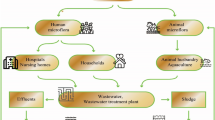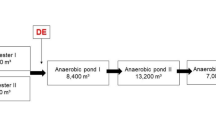Abstract
Antimicrobial agents in the environment are a cause for concern. Antimicrobial drug residues and their metabolites reach the aquatic and terrestrial environment primarily through wastewater treatment plants (WWTP). In addition to the potential direct negative health and environmental effects, there is potential for the development of antimicrobial-resistant bacteria. Residue levels below the minimum inhibitory concentration for a bacterial species can be important in selection of resistance. There is uncertainty associated with resistance formation during WWTP processing. A meta-analysis study was carried out to analyse the effect of WWTP processing on the levels of antimicrobial-resistant bacteria within bacterial populations. An analysis of publications relating to multiple antimicrobial-resistant (MAR) bacteria (n = 61), single antimicrobial-resistant (SAR) E. coli (n = 81) and quinolone/fluoroquinolone-resistant (FR) bacteria (n = 19) was carried out. The odds-ratio (OR) of MAR (OR = 1.60, p < 0.01), SAR (OR = 1.33, p < 0.01) and FR (OR = 1.19, p < 0.01) bacteria was determined. The results infer that WWTP processing results in an increase in the proportion of resistant bacteria in effluent, even though the overall bacterial population may have reduced (i.e. a reduction in total bacterial numbers but an increase in the percentage of resistant bacteria). The results support the need for further research into the development of antimicrobial-resistant strains and possible selective pressures operating in WWTPs.




Similar content being viewed by others
References
Bax, L. (2010). MIX 2.0. Professional software for meta-analysis in Excel. Version (2.0.0.7) (2.0 ed.), BiostatXL.
Bax, L., Yu, L.-M., Ikeda, N., Tsuruta, H., & Moons, K. (2006). Development and validation of MIX: Comprehensive free software for meta-analysis of causal research data. BMC Medical Research Methodology, 6(1), 50.
Bax, L., Yu, L. M., Ikeda, N., Tsuruta, H., & Moons, K. G. M. (2008). MIX: Comprehensive free software for meta-analysis of causal research data (1.7 ed.).
Bell, J. B., Elliott, G. E., & Smith, D. W. (1983). Influence of sewage treatment and urbanization on selection of multiple resistance in fecal coliform populations. Applied and Environment Microbiology, 46(1), 227–232.
Chalmers, T. C., Levin, H., Sacks, H. S., Reitman, D., Berrier, J., & Nagalingam, R. (1987). Meta-analysis of clinical trials as a scientific discipline. I: Control of bias and comparison with large co-operative trials (Vol. 6). New York: Wiley Subscription Services, Inc., A Wiley Company.
Coffey, R., Bergin, D., & Cummins, E. (2010). Use of meta-analysis to assess the effect of conventional water treatment methods on the prevalence of cryptosporidium spp. in drinking water. Human and Ecological Risk Assessment, 16(6), 1360–1378.
Cummins, E. (2008). The role of quantitative risk assessment in the management of foodborne biological hazards. International Journal of Risk Assessment and Management, 8(3), 318–330.
Cummins, E., Kennedy, R., & Cormican, M. (2010). Quantitative risk assessment of Cryptosporidium in tap water in Ireland. Science of the Total Environment, 408(4), 740–753.
DeCoster, J. (2009). Meta-analysis notes. Retrieved October 15th 2010. http://www.stat-help.com/Meta%20analysis%202009-07-31.pdf.
DerSimonian, R., & Laird, N. (1986). Meta-analysis in clinical trials. Controlled Clinical Trials, 7(3), 177–188.
Easterbrook, P. J., & Berlin, J. A. (1991). Publication bias in clinical research. Lancet, 337(8746), 867.
Egger, M., Smith, G. D., Schneider, M., & Minder, C. (1997). Bias in meta-analysis detected by a simple, graphical test. BMJ, 315(7109), 629–634.
Ferreira da Silva, M., Vaz-Moreira, I., Gonzalez-Pajuelo, M., Nunes, O. C., & Manaia, C. M. (2007). Antimicrobial resistance patterns in Enterobacteriaceae isolated from an urban wastewater treatment plant. FEMS Microbiology Ecology, 60(1), 166–176.
Gallert, C., Fund, K., & Winter, J. (2005). Antibiotic resistance of bacteria in raw and biologically treated sewage and in groundwater below leaking sewers (Vol. 69, Applied Microbiology & Biotechnology): Springer Science & Business Media B.V.
Garcia, S., Wade, B., & Bauer, C. (2007). The effect of wastewater treatment on antibiotic resistance in Escherichia coli and enterococcus sp. [Feature]. Water Environment Research, 79(12), 2387–2395.
George, I., Crop, P., & Servais, P. (2002). Fecal coliform removal in wastewater treatment plants studied by plate counts and enzymatic methods. Water Research, 36(10), 2607–2617.
Greenhouse, J. B., & Iyengar, S. (1994). Sensitivity analysis and diagnostics. In H. Cooper & L. Hedges (Eds.), Handbook of research synthesis (pp. 383–398). New York, NY: Russel Sage Foundation.
Grimwood, K., Collignon, P. J., Currie, B. J., Ferson, M. J., Gilbert, G. L., Hogg, G. G., et al. (1997). Antibiotic management of pneumococcal infections in an era of increased resistance. Journal of Paediatrics and Child Health, 33(4), 287–295.
Hassani, L., Imziln, B., & Gauthier, M. J. (1992). Antibiotic-resistant Escherichia coli from wastewater before and after treatment in stabilization ponds in the arid region of Marrakech, Morocco. Letters in Applied Microbiology, 15(5), 228–231.
Hirsch, R., Ternes, T., Haberer, K., & Kratz, K.-L. (1999). Occurrence of antibiotics in the aquatic environment. The Science of the Total Environment, 225(1–2), 109–118.
HPSC. (2008). Consumption of antibiotics in public acute hospitals in Ireland 2008 data.
Ibrahim, E. H., Sherman, G., Ward, S., Fraser, V. J., & Kollef, M. H. (2000). The influence of inadequate antimicrobial treatment of bloodstream infections on patient outcomes in the ICU setting (Vol. 118, CHEST). American College of Chest Physicians.
Ioannidis, J., & Trikalinos, T. A. (2007). The appropriateness of asymmetry tests for publication bias in meta-analyses: A large survey. Canadian Medical Association Journal, 176(8), 1091.
Jakobsen, L., Sandvang, D., Hansen, L. H., Bagger-Skjøt, L., Westh, H., Jørgensen, C., et al. (2008). Characterisation, dissemination and persistence of gentamicin resistant Escherichia coli from a Danish university hospital to the waste water environment. Environment International, 34(1), 108–115.
Kumarasamy, K. K., Toleman, M. A., Walsh, T. R., Bagaria, J., Butt, F., Balakrishnan, R., et al. (2011). Emergence of a new antibiotic resistance mechanism in India, Pakistan, and the UK: a molecular, biological, and epidemiological study. The Lancet Infectious Diseases, 10(9), 597–602.
Kümmerer, K. (2008). Pharmaceuticals in the environment: Sources, fate, effects and risks (3rd ed.). Berlin, Germany: Springer.
L’Abbe, K. A., Detsky, A. S., & O’Rourke, K. (1987). Meta-analysis in clinical research. Annals of Internal Medicine, 107(2), 224–233.
Lefkowitz, J. R., & Duran, M. (2009). Changes in antibiotic resistance patterns of escherichia coli during domestic wastewater treatment. Water Environment Research, 81, 878–885.
Lipsey, M. W., & Wilson, D. B. (2001). Practical meta-analysis (Vol. 49, Applied social research methods series). California, USA: SAGE.
Manaia, C., Novo, A., Coelho, B., & Nunes, O. (2010). Ciprofloxacin resistance in domestic wastewater treatment plants. Water, Air, and Soil Pollution, 208, 335–343.
Murray, G. E., Tobin, R. S., Junkins, B., & Kushner, D. J. (1984). Effect of chlorination on antibiotic resistance profiles of sewage-related bacteria. Applied and Environment Microbiology, 48(1), 73–77.
Nicolas-Chanoine, M.-H., Blanco, J., Leflon-Guibout, V., Demarty, R., Alonso, M. P., Canica, M. M., et al. (2007). Intercontinental emergence of Escherichia coli clone O25:H4-ST131 producing CTX-M-15. Journal of Antimicrobial Chemotherapy, dkm464. doi:10.1093/jac/dkm464.
O’Brien, N., & Cummins, E. (2010). Nano-scale pollutants: Fate in Irish surface and drinking water regulatory systems. Human and Ecological Risk Assessment: An International Journal, 16(4), 847–872.
Ochman, H., Lawrence, J. G., & Groisman, E. A. (2000). Lateral gene transfer and the nature of bacterial innovation. Nature, 405(6784), 299–304.
Payment, P., Plante, R., & Cejka, P. (2001). Removal of indicator bacteria, human enteric viruses, Giardia cysts, and Cryptosporidium oocysts at a large wastewater primary treatment facility. Canadian Journal of Microbiology, 47, 188–193.
Reinthaler, F. F., Posch, J., Feierl, G., Wüst, G., Haas, D., Ruckenbauer, G., et al. (2003). Antibiotic resistance of E. coli in sewage and sludge. Water Research, 37(8), 1685–1690.
Rolston, K. V. I. (2009). Bacterial infection in neutropenic cancer patients: An overview. Iranian Journal of Clinical Infectious Diseases, 4(2), 115–122.
Salgado, C. D., Dash, S., Cantey, J. R., & Marculescu, C. E. (2007). Higher risk of failure of methicillin-resistant staphylococcus aureus prosthetic joint infections. Clinical Orthopaedics and Related Research, 461, 48–53.
Samuelsen, Ø., Thilesen, C. M., Heggelund, L., Vada, A. N., Kümmel, A., & Sundsfjord, A. (2011). Identification of NDM-1-producing enterobacteriaceae in Norway. Journal of Antimicrobial Chemotherapy, 66(3), 670.
Sanders, C. C., Sanders, W. E. J., Goering, R. V., & Werner, V. (1984). Selection of multiple antibiotic resistance by quinolones, beta-lactams, and aminoglycosides with special reference to cross-resistance between unrelated drug classes. Antimicrobial Agents and Chemotherapy, 26(6), 797–801. doi:10.1128/aac.
Silva, J., Castillo, G., Callejas, L., Lopez, H., & Olmos, J. (2006). Frequency of transferable multiple antibiotic resistance amongst coliform bacteria isolated from a treated sewage effluent in Antofagasta, Chile. Electronic Journal of Biotechnology, 9(5), 533–540.
Varma, M., Field, R., Stinson, M., Rukovets, B., Wymer, L., & Haugland, R. (2009). Quantitative real-time PCR analysis of total and propidium monoazide-resistant fecal indicator bacteria in wastewater. Water Research, 43(19), 4790–4801.
Watkinson, A. J., Micalizzi, G. B., Graham, G. M., Bates, J. B., & Costanzo, S. D. (2007). Antibiotic resistant Escherichia coli in wastewaters, surface waters and oysters from an urban riverine system. Applied and Environmental Microbiology, AEM.00763-00707. doi:10.1128/aem.00763-07.
Whitehead, A. (2002). Meta-analysis of controlled clinical trials. Sussex, England: Wiley.
Wiener, J., Quinn, J. P., Bradford, P. A., Goering, R. V., Nathan, C., Bush, K., et al. (1999). Multiple antibiotic-resistant klebsiella and escherichia coli in nursing homes. JAMA, 281(6), 517–523. doi:10.1001/jama.281.6.517.
Zhang, Y., Marrs, C. F., Simon, C., & Xi, C. (2009). Wastewater treatment contributes to selective increase of antibiotic resistance among Acinetobacter spp. Science of the Total Environment, 407(12), 3702–3706.
Acknowledgments
The authors would like to acknowledge the Irish EPA for the funding of this project, under the STRIVE programme (2007-2013).
Conflict of interest
The authors declare that they have no conflict of interest.
Author information
Authors and Affiliations
Corresponding author
Rights and permissions
About this article
Cite this article
Harris, S., Cormican, M. & Cummins, E. The effect of conventional wastewater treatment on the levels of antimicrobial-resistant bacteria in effluent: a meta-analysis of current studies. Environ Geochem Health 34, 749–762 (2012). https://doi.org/10.1007/s10653-012-9493-8
Received:
Accepted:
Published:
Issue Date:
DOI: https://doi.org/10.1007/s10653-012-9493-8




